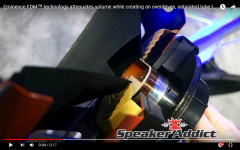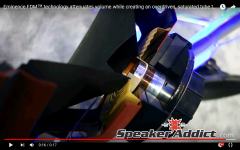Scott,
The angle of incidence does matter. The sign of an amateur is they point the microphone straight at the source. A pro uses a seventy degree offset as that is close enough for most measurements particularly with a one inch microphone.
As to vibration placing the loudspeakers perpendicular to the axis of motion should help clean things up. I would also consider using a sand box to hold each item including the microphone stand.
Did we almost agree on something?
I'll have to check the weather forecast to see if the sky is falling! 😉
The angle of incidence does matter. The sign of an amateur is they point the microphone straight at the source. A pro uses a seventy degree offset as that is close enough for most measurements particularly with a one inch microphone.
As to vibration placing the loudspeakers perpendicular to the axis of motion should help clean things up. I would also consider using a sand box to hold each item including the microphone stand.
Did we almost agree on something?
I'll have to check the weather forecast to see if the sky is falling! 😉
Last edited:
What do-you mean exactly by "exactly" ? ;-)No problem, It helped a lot that your 200Hz was exactly 200Hz if possible to 10k should be too.
Last edited:
What do-you mean exactly by "exactly" ? ;-)
Leakage < 90db or so with unwindowed FFT. Perfect synchronous FFT is ~-300dB. I was trying to avoid windowing and more details to worry about.
The original technique worked very well for the LP speed plot but there the errors are gross, this is just a new problem to solve (keeps the "retired" brain active).
I would also consider using a sand box to hold each item including the microphone stand.
Did we almost agree on something?
I'll have to check the weather forecast to see if the sky is falling! 😉
Yes I used the burial in sand technique to measure microphone noise floor, it works amazingly well. Funny story, there was a B&K isolation "egg" on ebay for about 5% of MSRP and I passed on it. A few weeks later I saw it sitting in our MEMS lab, yup same one.
You are right about the low frequency stuff, I went 3 miles off shore to an island in ME and got up at 4AM and found the lobsterman's motors from miles away still created massive subaudible noise.
We agree more than you think.
That was the purpose of my joke. A philosophical question about the impossible perfection.(keeps the "retired" brain active).
Hats off :I went 3 miles off shore to an island in ME and got up at 4AM and found the lobsterman's motors from miles away still created massive subaudible noise.
The guy, half awake, able to hear subaudible noises at 4 in the morning, while i sould not be able to notice the ring of my alarm clock.
Last edited:
The guy, half awake, able to hear subaudible noises at 4 in the morning, while i sould not be able to notice the ring of my alarm clock.
That was for a microphone test, they "heard" the noise.
Test of the SSM2019 ?That was for a microphone test, they "heard" the noise.
Test of the SSM2019 ?
No I was comparing the Rode NT1a to my DIY mics for my Linear Audio article. I never used the data but I could not seriously differentiate the noise performnce. You would be surprised at how good this electret capsule can be at ~$60. http://www.micbooster.com/documents/EM23.pdf
We agree more than you think.
That would explain today's storm with bowling ball size hail! 😉
Actually bright and sunny.
That would explain today's storm with bowling ball size hail! 😉
Actually bright and sunny.
Wasn't that just the old bearded guys playing nine pins?
Everybody die. Only strikes.Wasn't that just the old bearded guys playing nine pins?


Eminence patent-pending FDM™ technology
Movable polepiece, $120.00, useful for investigations ?.
Dan.
Last edited:
Scott,
The angle of incidence does matter. The sign of an amateur is they point the microphone straight at the source. A pro uses a seventy degree offset as that is close enough for most measurements particularly with a one inch microphone.
As to vibration placing the loudspeakers perpendicular to the axis of motion should help clean things up. I would also consider using a sand box to hold each item including the microphone stand.
Did we almost agree on something?
I'll have to check the weather forecast to see if the sky is falling! 😉
yep (omni)
🙂 😎
-RNM
Last edited:
The article doesnt mention what S7000 is talking about. But it wouldnt matter if measuring at <1cm.
However, FR of speaker is not of concern here -- we want to know the distortion. And, thus the distortion of the microphone and its' preamp is needed.
The power into the speaker to produce a 80-90dB spl at the microphone <1 cm from driver will be unrealistically low. And, so will the THD from the speaker. Measured this way allows for the assumption all is well and very low audible distortion.
80-90 dB spl further back in a living room size will exercise the driver to a more realistic THD level.
If you measure at 8-12 feet away... in a large room (living room size). then the mic response off axis will skew the data if not perfectly omni. Esp true from a 1 inch diam mic. [Gating/windowing technics can be used to eliminate reflections from the data if measuring in anything other than an anechoic chamber]
I suspect the mic used for FR that are inexpensive though flat FR are Not good enough for THD measurements or low enough to see any improvements in speaker design/mods. How can we, the DIY'er, find out?
-RNM
Last edited:
+1. Standing wave has to be avoided as much as possible.yep (omni)
Who would photograph a window from face ?
Avoiding any réflexions from the microphone itself is the reason why measurement mics has a diameter as little as possible.
Last edited:
Completely missed the swept sine wave/tracking filter TEF method, probably still a very common pro technique.
Also another issue is do you want a flat frequency response out of the loudspeaker or at the listener's position.
In a professional live reinforcement situation equalization is used to maximize gain before feedback and often to establish a "House Curve." Usually a bass bump and rolled off high frequencies!
In a recording studio the goal is flat frequency response at the mixing position.
Then there was no distinction between flat frequency response and flat energy response.
Also another issue is do you want a flat frequency response out of the loudspeaker or at the listener's position.
In a professional live reinforcement situation equalization is used to maximize gain before feedback and often to establish a "House Curve." Usually a bass bump and rolled off high frequencies!
In a recording studio the goal is flat frequency response at the mixing position.
Then there was no distinction between flat frequency response and flat energy response.
I thought we were talking about measuring distortion (both harmonic and doppler) to a fine degree. I'm interested in how stationary the measurement setup is and if it matters because it's a potential confounder (or not).
About the B652 speaker mentioned a few days ago, for those interested in measurements:
Updated Dayton B652 Review
It seems the originals are a bit of a disaster, but the AMT version could probably be improved a lot with the proper crossover:
Dayton B652 AIR Review
Updated Dayton B652 Review
It seems the originals are a bit of a disaster, but the AMT version could probably be improved a lot with the proper crossover:
Dayton B652 AIR Review
I thought we were talking about measuring distortion (both harmonic and doppler) to a fine degree. I'm interested in how stationary the measurement setup is and if it matters because it's a potential confounder (or not).
That was one of the issues, but insulting folks here is apparently the major topic.
An example of reference to authority swipe. However the authority wasn't really an authority and probably hasn't ever really done such work.
Last edited:
- Status
- Not open for further replies.
- Home
- Member Areas
- The Lounge
- John Curl's Blowtorch preamplifier part III